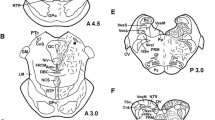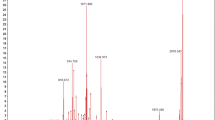Abstract
In previous communications [4, 38] we published that [3H]Met-enkephalin-Arg6-Phe7 (MERF) binds to opioid (kappa2 and delta) and sigma2 sites in frog and rat brain membrane preparations, however no binding to kappa1 sites could be established. In the present paper we compare the frog, rat and guinea pig brain membrane fractions with respect to their MERF binding data. No qualitative differences were found between the three species but specific binding of labelled MERF was maximal in frog brain and lowest in guinea pig brain, which corresponds to their kappa2 opioid receptor distribution. The naloxone resistant binding was also present in all investigated species and varied from 25% in frog and guinea pig cerebrum, to 50% in rat cerebrum and cerebellum, but no naloxone inhibition was found in guinea pig cerebellum where no kappa2 opioid receptors have been found. The presence of sigma2-like receptor was demonstrated in each investigated membrane fraction with displacement experiments using (–)N-allyl-normetazocine as competitor of tritiated MERF. It was shown that this site was responsible for 60–80% of [3H]MERF binding. The remaining part of the naloxone resistant labelled MERF binding could be displaced only with endogenous opioid peptides as met-enkephalin, dynorphin and ß-endorphin. The eventual physiological role of multiple MERF receptors is discussed.
Similar content being viewed by others

References
Attali, B., Gouarderes, C., Mazarguil, H., Audigier, Y., Cros, J. (1982) Evidence for multiple kappa binding sites of opioid peptides in the guinea pig lumbo-sacral spinal cord. Neuropeptides 3, 53–64.
Benyhe, S., Varga, E., Hepp, J., Magyar, A., Borsodi, A., Wollemann, M. (1990) Characterization of kappa1 and kappa2 opioid binding sites in frog (Rana esculenta) brain membrane preparation. Neurochem. Res. 14, 205–210.
Benyhe, S., Szűcs, M., Borsodi, A., Wollemann, M. (1992) Species differences in the stereoselectivity of kappa opioid binding sites for [3H]U–69593 and [3H]ethylketocyclazocine. Life Sciences 51, 1647–1655.
Benyhe, S., Farkas, J., Tóth, G., Wollemann, M. (1997) Met5-enkephalin-Arg6-Phe7, an endogenous neuropeptide, binds to multiple opioid and nonopioid sites in rat brain. J. Neurosci. Res. 48, 249–258.
Benyhe, S., Farkas, J., Tóth, G., Wollemann, M. (1999) Characterization of [3H]Met-enkephalin-Arg6-Phe7 binding to multiple sites in rat and guinea pig cerebellum. Life Sci. 64, 1189–1196.
Bradford, M. M. (1976) A rapid and sensitive method for the quantitation of microgram quantities of protein utilizing the principle of ptotein-dye binding. Analyt. Biochem. 72, 248–254.
Caudle, R. M., Chavkin, C., Dubner, R. (1994) K2 opioid receptors inhibit NMDA receptor-mediated synaptic currents in guinea pig CA3 pyramidal cells. J. Neurosci. 14, 5580–5589.
Chen, L., Huang, L. Y. M. (1998) Dynorphin block of N-methyl-D-aspartate channels increases with the peptide length. J. Pharmacol. Exp. Ther. 284, 826–831.
Couture, S., Debonnel, G. (1998) Modulation of the neural response to N-methyl-D-aspartate by selective sigma2 ligands. Synapse 29, 62–71.
Giraud, P., Castanas, E., Patey, G., Oliver, C., Rossier, J. (1983) Regional distribution of methionine-enkephalin-Arg6-Phe7 in the rat brain: comparative study with the distribution of other opioid peptides. J. Neurochem. 41, 154–160.
Gouarderes, C., Cros, J. (1984) Opioid binding sites in different levels of rat spinal cord. Neuropeptides 5, 113–116.
Hazum, E., Chang, K.-J., Cuatrecasas, P. (1979) Specific nonopiate receptors for beta-endorphin. Science 205, 1033–1035.
Inturrisi, C. E., Umans, J. G., Wolff, D., Stern, A. S., Lewis, R. V., Stein, S., Udenfriend, S. (1980) Analgesic activity of the naturally occuring heptapeptide [Met]enkephalin-Arg6-Phe7. Proc. Natl. Acad. Sci. 77, 5512–5514.
Kieffer, B. L., Befort, K., Gaveriaux-Ruff, C., Hirth, C. G. (1992) The delta-opioid receptor: Isolation of a cDNA by expression cloning and pharmacological characterization. Proc. Natl. Acad. Sci. 89, 12048–12052.
Kilpatrick, D. L., Howells, L. D., Lahm, H. W., Udenfriend, S. (1983) Evidence for proenkephalin-like precursor in amphibian brain. Proc. Natl. Acad. Sci. 80, 5772–5775.
Lai, S. L., Gu, Y., Huang, L. Y. M. (1998) Dynorphin uses a non-opioid mechanism to potentiate N-methyl-D-aspartate currents in single rat periaqueductal gray neurons. Neurosci. Lett. 247, 115–118.
Leatherbarrow, R. J. (1992) GraFit Version 3.0, Erithacus Software Ltd., Staines, U.K.
Li, X., Jr. Keith, D. E., Evans, C. J. (1996) Multiple opioid receptor-like genes are identified in diverse vertebrate phyla. FEBS Lett. 397, 25–29.
Mansour, A., Hoversten, M. T., Taylor, L. P., Watson, S. J., Akil, H. (1995) The cloned mu, delta and kappa receptors and their endogenous ligands: Evidence for two opioid peptide recognition cores. Brain Res. 700, 89–98.
Meng, F., Xie, G. X., Thompson, R. C., Mansour, A., Goldstein, A., Watson, S. J., Akil, H. (1993) Cloning and pharmacological characterization of a rat kappa opiate receptor. Proc. Natl. Acad. Sci. 90, 9954–9958.
Meunier, J. C., Mollereau, C., Toll, L., Suaudeau, C., Moisand, C., Alvinerie, P., Butour, J. L., Guillemot, J. C., Ferrara, P., Monsarrat, B., Mazarguil, H., Vassart, G., Parmentier, M., Costentin, J. (1995) Isolation and structure of the endogenous agonist of opioid receptor-like ORL1 receptor. Nature 377, 532–535.
Mollereau, C., Parmentier, M., Mailleux, P., Butour, J. L., Moisand, C., Chalon, P., Caput, D., Vassart, G., Meunier, J. C. (1994) ORL1, a novel member of the opioid receptor family. Cloning, functional expression and localization. FEBS Lett. 341, 33–38.
Munson, P. J., Rodbard, D. (1980) LIGAND: a versatile computerized approach for characterization of ligand binding systems. Analyt. Biochem. 107, 220–239.
Pasternak, G. W., Wilson, H. A., Snyder, S. H. (1975) Differential effects of protein modifying reagents on receptor binding of opiate agonists. Mol. Pharmacol. 11, 340–351.
Perregaard, J., Moltzen, E. K., Meier, E., Sanchez, C. (1995) Sigma ligands with subnanomolar affinity and preference for the sigma2 binding site. 1.3-(omega-aminoalkyl)-1H-indoles. J. Med. Chem. 38, 1998–2008.
Porreca, F., Ossipov, M. H., Hruby, V. J., Malan, T. P., Lai, J. (1998) Physiological and pharmacological actions of dynorphin in pain. INRC 29, Abstracts p. 31.
Price, M., Gistrak, M. A., Itzhak, Y., Hahn, E. F., Pasternak, G. W. (1989) Receptor binding of [3H]naloxone-benzoylhydrazone: a reversible kappa and slowly dissociable mu opiate. Mol. Pharm. 35, 67–74.
Quirion, R., Bowen, W. D., Itzhak, Y., Junien, J. L., Musacchio, J. M., Rothman, R. B., Su, T. P., Tarn, S. W., Taylor, D. P. (1992) A proposal for the classification of sigma binding sites. Trends Pharmacol. Sci. 13, 85–86.
Reinscheid, R. K., Nothacker, H. P., Bourson, A., Ardati, A., Henningsen, R. A., Bunzow, J. R., Grandy, D. K., Langen, H., Monsma, F. J., Civelli, O. (1995) Orphanin FQ: a neuropeptide that activates an opioid like G protein-coupled receptor. Science 270, 792–794.
Rossier, J., Audigier, Y., Ling, N., Cros, J., Udenfriend, S. (1980) Met-enkephalin-Arg6-Phe7, present in high amounts in brain of rat, cattle and man, is an opioid agonist. Nature 288, 88–90.
Shukla, V. K., Lemaire, S. (1994) Non-opioid effects of dynorphins: possible role of the NMDA receptor. Trends Pharmacol. Sci. 15, 420–424.
Stern, A. S., Lewis, R. V., Kimura, S., Rossier, J., Gerber, L. D., Brink, L., Stein, S., Udenfriend, S. (1979) Isolation of the opioid heptapeptide Met-enkephalin [Arg6, Phe7] from bovine adrenal medullary granules and striatum. Proc. Natl. Acad. Sci. 76, 6680–6683.
Tang, J., Yang, H-Y T., Costa, E. (1982) Distribution of Met-enkephalin-Arg6-Phe7 in various tissues of rat and guinea pig brain. Neuropharmacology 21, 595–597.
Thompson, R. C., Mansour, A., Akil, H., Watson, S. J. (1993) Cloning and pharmacological characterization of a rat mu receptor. Neuron 11, 903–913.
Tóth, G., Kramer, T. H., Knapp, R. J., Lui, G. K., Davis, P., Burks, T. F., Yamamura, H. I., Hruby, V. J. (1990) [D-Pen2-D-Pen5]enkephalin analogues with increasing affinity and selectivity for delta-opioid receptors. J. Med. Chem. 33, 249–253.
Walker, J. M., Moises, H. C., Coy, D. H., Baldrighi, G., Akil, H. (1982) Nonopiate effects of dynorphin and des-Tyr-dynorphin. Science 218, 1136–1138.
Walker, J. M., Bowen, W. D., Patrick, S. L., Williams, W. E., Mascarella, S. W., Bai, X., Carroll, F. I. (1993) A comparison of (–)deoxybenzomorphans devoid of opiate activity with their dextrorotatory phenolic counterparts suggests role of sigma2 receptors in motor function. Eur. J. Pharmacol. 231, 61–65.
Wollemann, M., Farkas, J., Tóth, G., Benyhe, S. (1994) Characterization of [3H] Met-enkephalin-Arg6-Phe7 binding to opioid receptors in frog brain membrane preparations. J. Neurochem. 63, 1460–1465.
Wollemann, M. (1994) Discrepancies between identical amino acid sequences of cloned opioid receptor subtypes and their binding sites. Trends NeuroSci. 17, 337.
Zukin, R. S., Eghbali, M., Olive, D., Unterwald, E. M., Tempel. A. (1988) Characterization and visualization of rat and guinea pig brain kappa1 and kappa2 opioid recptors. Proc. Natl. Acad. Sci. 85, 4061–4065.
Author information
Authors and Affiliations
Additional information
Dedicated to Professor János Salánki for his 70th birthday.
Rights and permissions
About this article
Cite this article
Wollemann, M., Farkas, J., Tóth, G. et al. Comparison of the endogenous heptapeptide Met-enkephalin-Arg6-Phe7 binding in amphibian and mammalian brain. BIOLOGIA FUTURA 50, 297–307 (1999). https://doi.org/10.1007/BF03543051
Received:
Accepted:
Published:
Issue Date:
DOI: https://doi.org/10.1007/BF03543051



